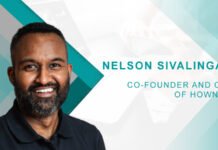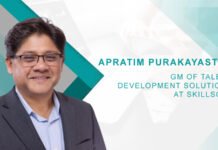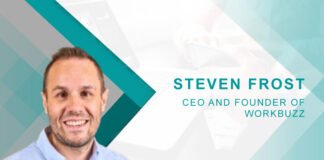To start, can you please tell us about your professional journey and what led you to your current role?
My career has been driven by a desire to help organizations optimize their workforce and achieve strategic goals. At each step of my professional journey, I’ve put a particular focus on leadership, performance reporting, accounting and operations, honing my experience within the investment management industry and workforce analytics consulting.
I started out at State Street, working my way up from an Associate in Fund Accounting to Finance Manager over the course of a decade before landing at Magnit as a Senior Business Consultant in 2017. It was here that I found my specialty in market intelligence for workforce strategy and human capital management, eventually coming to my current role as the Senior Director of Magnit Strategic Advisory. In this position, I’m proud to play a part in helping Magnit’s clients optimize their talent and diversity goals and adapt to the evolution of work, empowering them to grow their extended workforce with greater agility, transparency, and speed.
We’re seeing increased interest in alternative workforce models—gig, freelance, contract, and remote roles. What short-term and long-term impacts do you think this shift will have on both organizations and workers?
Organizations and workers alike are facing increased uncertainty in the economy and labor market, making workforce agility truly invaluable. As the market shifts, companies need to be able to quickly right size their workforces, filling in skills gaps and headcount while workers are looking for opportunities to grow their experience as the in-demand skills change on their own terms and boost financial health through consistent employment. To that end, both are turning their focus to avenues proven to sustain flexibility, which includes alternative workforce models.
Starting with employers in the short-term, organizations will have to adapt their operational structures, policies, and company culture to accommodate the needs unique to alternative workforce models. For example, investing in digital tools and infrastructure to connect remote workers with their in-person counterparts or ensuring procurement and legal teams are up to date on the different compliance requirements between gig or freelance workers and full-time workers. Looking to the long-term impacts, embracing a contingent workforce grants organizations access to a broader talent pool, enhancing the workforce with specialized skillsets and high-level experience. However, those long-term benefits can’t be realized without the short-term investments to optimize operations for alternative workforce models.
Turning attention to workers, switching to a contingent role comes with an immediate increase in autonomy and flexibility. However, this cuts both ways and can have long-term impacts – workers have more control over their hours and which opportunities they pursue but also take on more responsibility for managing their own finances and maintaining a consistent career path.
Fill rates for temporary roles have been dropping. What are the underlying reasons for this trend, and how should organizations be responding?
The drop in fill rates has been significant, with January and February falling 30% year-over-year. This type of downturn is common when recession is on the horizon, and while we are seeing the steep decline come to fruition, an official recession has yet to materialize. As such, there are several possible explanations for what might be happening.
One is the shift toward alternative workforce models and Statement of Work (SOW). As new part-time work models gain traction, traditional temporary roles with strict hours and structure are becoming less attractive. In terms of how organizations can respond, they must find opportunities to make their available temporary roles more competitive with the freedoms of freelancing or gig work. Offering better pay rates, an efficient hiring and onboarding process, or providing perks like upskilling trainings can give fill rates a boost, especially as many market factors like increasing cost-of-living or a tightening labor market are largely out of organizational control.
Another possibility is that the rapid increase in interest rates locked access to capital, ultimately forcing organizations to slow down project progress as well as temporary hiring efforts. At the same time, voluntary terminations fell to 13% earlier this year in a historic low. With fewer workers quitting, the replacement hiring that would normally follow has fallen off as well. It also must be mentioned that we are currently in a rolling recession, meaning certain industries are contracting as others expand, which will have an impact on hiring, both temporary and full-time.
There’s a noticeable “wait and see” mindset among job seekers right now. How are market factors like tariff uncertainty, recession fears, and AI adoption contributing to that hesitation?
The uncertainties of the new administration’s tariff policies and broader economic struggles, combined with persistently high layoff rates, have resulted in voluntary terminations hitting an all-time low. In fact, according to a survey Magnit conducted in partnership with Dynata, 59% of workers are currently not seeking a new role.
Workers are taking an increasingly cautious approach to the job market, with a premium being put on security. Most are reluctant to leave a stable role for a new opportunity, more afraid of potential layoffs or disruptions stemming from tariff-driven tensions than they are of limiting career mobility.
In terms of AI, as the technology has advanced and become more widespread, there are lingering concerns over how current job titles might change or even be eliminated. For those in administrative or lower-level tech roles in particular, fears over how automation will affect their industry have created a lull in career moves. Some workers are prioritizing reskilling or upskilling to make themselves more competitive in an AI-forward job market, but those programs take time to complete, and workers are staying put in the meantime.
On the flip side, how are these same factors influencing how companies are shaping their hiring strategies in the current climate?
Like job seekers, companies are taking the same “let’s see what happens” approach to hiring strategies, monitoring how new tariff policies, trade wars, a looming recession, and the potential behind AI will change the economy. The savviest organizations are tapping into flexible labor solutions to help power business continuity and better position themselves for future growth opportunities.
Contract or temporary workforces allow companies to stay agile and quickly adapt to unpredictable supply chain disruptions. Especially for businesses with a global footprint, tariffs are a significant unknown long-term and may push decision-makers to delay, if not completely freeze, hiring strategy. Recession fears are having a similar impact. Instead of expanding external hiring, companies are being more selective, promoting internally and investing in upskilling infrastructure to make the most of the workforce already available and avoid the costs of training new employees.
On the AI front, many companies are still trying to determine which roles will be augmented by the technology and what the impact will be on hiring strategy. While some organizations are taking a leaner approach, asking a smaller workforce to take on more responsibility with the support of AI tools, others are shifting focus to AI-experienced talent, only hiring workers well-versed in managing AI tools.
There’s been a growing disconnect between time-to-fill rates and demand for contingent labor. Why are fill times increasing even as demand for these roles decreases?
Typically, as time to fill rates increase, so too does the demand for contingent workers. And yet, outside of the healthcare sector, time to fill has seen a 5% uptick year-over-year (increasing from 19.4 days to 20.4 days on average) even as contingent hiring has slowed. There are four key factors that may explain this unusual trend, starting with a potential mismatch between the expertise employees have and what employers need.
If the available candidate pool doesn’t meet the required qualifications or skills an organization is looking for, the hiring process will take longer. In-demand skillsets are also constantly evolving, making it difficult to fully align this mismatch, even if the demand for workers is present.
Additionally, hiring priorities have drastically shifted in response to market uncertainty, with many companies now operating under budget constraints or being asked to do more with less staff. Under these new pressures, leadership is inclined to take longer in making final candidate decisions to ensure any new hires are aligned with where their business strategy may be heading.
We’re also seeing artificial intelligence make significant inroads in recruiting practices, and with the adoption of any new tool, there is bound to be a transitionary period. As hiring managers and candidates learn the ins and outs of these AI-powered tools, new inefficiencies are likely to emerge, ultimately extending the time from recruitment to hiring and onboarding.
Finally, most candidates are less willing to take on-site temporary positions given the prevalence of hybrid or fully remote roles. Push back on return to office mandates, especially from temporary workers used to a certain level of freedom in where and how they work.
What advice would you give to organizations looking to refine their talent strategies in light of longer fill times and lower application rates?
To refine talent strategies amid longer fill times and lower application rates, organizations should adopt a structured, data-driven workforce strategy that maps talent priorities directly back to business goals. Alignment across all business units interacting with talent – whether its procurement, talent acquisition, IT, or other operational departments – is critical for fostering engagement among contingent workers.
This means leveraging agile forecasting models that integrate market intelligence and real-time pay benchmarking, which ultimately enables more accurate predictions for hiring costs and time-to-fill, and ensures that talent supply chains are responsive to both immediate and long-term needs.
Additionally, organizations should optimize their end-to-end talent acquisition pipeline, utilizing avenues such as direct sourcing from internal talent pools and streamlining onboarding processes to boost competitiveness in a market increasingly favoring alternative workforce models. Transparent communication and clear alignment between workforce planning and business objectives are key, as is empowering stakeholders with actionable insights and supporting more effective, flexible hiring decisions.
When it comes to compensation, what are you seeing in terms of pay rate trends, and how should both employers and employees think about wage growth heading into the future?
Wages are generally holding steady across non-healthcare sectors, though certain brackets are experiencing slight growth. Specifically, lower wage bracket workers, including those in light industrial, manufacturing, and operations, have seen improvement in their pay rates. Between 2019 and 2024, the hourly wage for the lowest paid workers grew by 15.4%, outpacing wage growth at the upper levels of wage distribution.
While wage growth has remained steady, employees and employers must be prepared for pay rates to change, as even minor adjustments in inflation can have a large effect on the cost of living and materials. Employers must be proactive in their planning process, leaving room to increase wages or benefits as needed to remain competitive and achieve sustainable success, even in a volatile market.
On a personal level, what’s your approach to navigating unpredictable shifts in labor market trends, and how do you stay ahead of what’s next?
Navigating today’s unpredictable labor market requires more than just access to data, it demands purposeful action, strategic foresight, and a deep commitment to client partnership. I take pride in helping our clients stay one step ahead by blending real-time labor data, compensation intelligence, and a conscious use of AI with thoughtful industry-specific advisory.
My approach starts with continuous market monitoring and scenario-based forecasting, allowing us to anticipate shifts in supply, demand, and candidate behavior, ideally before they impact business outcomes. By managing the full analytics pipeline, from data collection to dashboard delivery, we ensure that insights are not only timely but directly aligned to our clients’ evolving priorities. What drives me most is turning complexity into clarity.
I believe in translating trends into meaningful, business-aligned strategies that empower decision-makers and support workforce agility. In a year where many organizations are facing tighter budgets and heightened uncertainty, our ability to deliver flexible contingent workforce strategies has been vital. I’m genuinely passionate about helping clients navigate these challenges—not just reactively, but with confidence and control. That partnership mindset is what fuels our work and ultimately delivers real impact.
Finally, any closing thoughts or key takeaways you’d like to leave with our readers as they navigate today’s changing workforce landscape?
In the current macro environment, where concerns over economic uncertainty are at a high and disruptions from new technologies and use cases emerge daily, agility is one of the most valuable things an organization can possess. A contingent workforce provides that agility in spades, allowing companies to quickly adjust the size and skillset of their workforce as the market shifts and business goals change.
Equally important is the ability to maintain a competitive edge and encourage innovation without exorbitant costs. By embracing contingent work, businesses enter a win-win situation – the freedom to right size regardless of what the economic landscape throws their way and the talent infrastructure to promptly respond to new market opportunities while maintaining control over costs.

Robert Lucido Senior Director of Magnit Strategic Advisory
As the Senior Director of Magnit Strategic Advisory, Robert Lucido oversees the team responsible for analytics and advisory consulting services for Magnit’s clients across clinical, commercial, and market intelligence settings. Specializing in the strategic design and implementation of market research projects in the human capital management market and contingent workforce, Robert brings extensive experience in providing actionable insights and advice on talent management, recruitment, retention, and organizational design. Prior to Magnit, Robert spent 10 years at State Street, operating in several positions across financial management.












